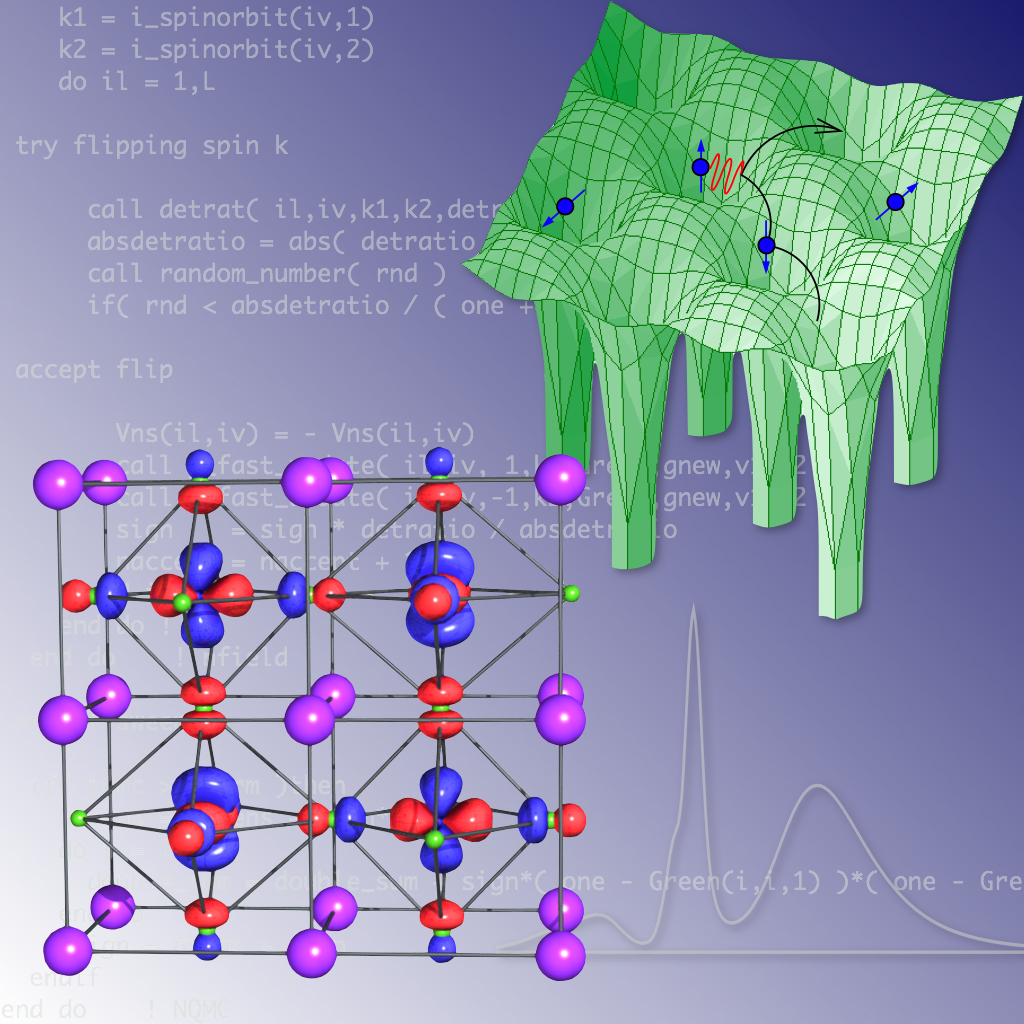Research Projects
Current Research Projects
- New methods for correlated materials
Robert Schade and Peter E. BlöchlTransition metal oxides such as Perovskites exhibit special properties, which make them technologically extremely interesting. Some of them exhibit superconducting properties, other metal-insulator transitions.
This zoo of properties has been attributed to electron correlations. Correlated electrons do no more act as individual particles but they join each other into a dance of startling complexity. In constrast to normal materials the prediction of their properties using ab-initio simulations is still in its infancy.
The goal of these project is to explore new methods to describe the main correlation effects with the sufficient accuracy, but also with a computational effort that allows large structures such as interfaces between different correlated materials to be explored.
 This project is part of the DFG Research Unit
FOR1346
"Dynamical Mean-Field Approach with Predictive Power for
Strongly Correlated Materials". The project is performed
bilocally at Clausthal University of Technology and the group
of Prof. Thomas Pruschke from Gottingen University.
This project is part of the DFG Research Unit
FOR1346
"Dynamical Mean-Field Approach with Predictive Power for
Strongly Correlated Materials". The project is performed
bilocally at Clausthal University of Technology and the group
of Prof. Thomas Pruschke from Gottingen University.
- Dynamics of phonons and thermoelectric
materials
Debanjan Basu and Peter E. BlöchlIn this project we investigate elementary processes of phonon scattering and thermal transport on different levels of theory. One study approaches the problem from the side of molecular dynamics simulations. The other extracts the phonon scattering matrix elements and solves the phonon-Boltzmann equation.
This project is part of the Project "Understanding size- and interface dependent anisotropic thermal conduction in correlated multilayer structures" within DFG priority program SPP1386 "Nanostructured Thermoelectrics: Theory, model systems and controlled synthesis". The project is performed bilocally at Clausthal University of Technology and the Institute for Materials Physics at Göttingen University
- Photolytic water splitting
Philipp Seichter and Peter Blöchl We investigate
the elementary processes of photolytic water splitting. The
motivation is to become able to guide the search for new
catalyst that allow the production hydrogen as "solar fuel"
from light and water. Simultaneously, we explore the corrosion
processes of within the catalyst. Corrosion, which is
chemically similar to the water splitting reaction, is a
competitor for the catalytic reaction, because it destroyes
the catalyst.
We investigate
the elementary processes of photolytic water splitting. The
motivation is to become able to guide the search for new
catalyst that allow the production hydrogen as "solar fuel"
from light and water. Simultaneously, we explore the corrosion
processes of within the catalyst. Corrosion, which is
chemically similar to the water splitting reaction, is a
competitor for the catalytic reaction, because it destroyes
the catalyst.
 This project is part of the
Project "From electron transfer to chemical energy storage:
first principles studies of correlated processes" within DFG
colaborative Research centre
SFB1073
"Atomic scale control of energy conversion".
This project is part of the
Project "From electron transfer to chemical energy storage:
first principles studies of correlated processes" within DFG
colaborative Research centre
SFB1073
"Atomic scale control of energy conversion".
- Energy relaxation in manganates
Peter Blöchl This project is part of the
Project "Relaxation, thermalization,transport and condensation
in highly excited solids" within DFG colaborative Research
centre
SFB1073
"Atomic scale control of energy conversion".
This project is part of the
Project "Relaxation, thermalization,transport and condensation
in highly excited solids" within DFG colaborative Research
centre
SFB1073
"Atomic scale control of energy conversion". - Development of the CP-PAW code
Robert Schade and Peter BlöchlDie Arbeiten in der Abteilung für Angewandte Theoretische Physik basieren auf der vom Leiter der Abteilung entwickelten Methode Projektor augmentierter Wellen. Diese Methode wird heute als die modernste Elektronenstrukturmethode für ab-initio simulationen angesehen. Das darauf aufbauende CP-PAW Programmpaket wird ständig weiterentwickelt und um neue Optionen erweitert.
More details ... - Object-oriented programming
Peter BlöchlDie Entwicklung und Verwaltung komplexer Programmpakete stellt eine besondere Herausforderung dar. Das Paradigma des Object-Oriented Programming bietet hier eine notwendige Alternative. Das Programm wird nicht mehr als eine Einheit, sondern als Ansammlung weitgehen unabhängiger und mehr oder weniger intelligenter Agenten angesehen. Der Informationsaustausch zwischen den Agenten wird durch geeignetes Programmdesign minimiert, was es dem Entwickler erlaubt, einzelne Agenten zu bearbeiten, ohne die Komplexität des gesamten Programmes zu überblicken zu müssen. Eine besondere Herausforderung war es, die Konzepte in Fortran90 zu übertragen, das sich besonders für numerische Problemstellungen eignet. Dazu wurde eine zum Beispiel eine Metasprache erzeugt, die es erlaubt sogenannte Templates zu erzeugen.
- Parallel computing
Axel Ehrich, Juergen Noffke, Robert Schade and Peter BlöchlDer Umfang von Ab-Initio Simulationen erfordert die Nutzung von Parallelrechnern. Wir haben das CP-PAW Programmpaket bereits etwa 1995 an die damals gerade aufkommenden Parallelrechner angepasst. Hierbei legen wir eine MIMD (Multiple Instruction-Multiple Data) Parallelisierung zugrunde. Die Kommunikationsbefehle wurden verpackt, sodass die Details der Kommunikation bei der Programmierung der Anwendung nur soweit als nötig sichtbar werden. Das war wesentlich um die Übersichtlichkeit der komplexen Anwendungssoftware zu bewahren. Das Loadbalancing wird automatisch zu Beginn der Simulation optimiert.
- High-performance computing
A. Ehrich, Juergen Noffke, Robert Schade und Peter BlöchlDa ab-initio Simulationen sehr rechenintensiv sind, sind diese auf Parallelrechner angewiesen. Neben dem IBM 460 pSeries Superrechner des Norddeutschen Rechnerverbundes HLRN, wird daher eine lokale Resource aus Beowulfclustern aufgebaut. Beowulfcluster sind Parallelrechner, die sozusagen selbstgestrickt sind und aus Standardkomponenten aufgebaut sind. Da ausserdem ausschliesslich frei erhältliche Software, (Linux, Message Passing interface) zum Einsatz kommt, zeichnen sich Beowulfcluster durch ein ausgezeichnetes Preis-Leistungsverhältniss aus.
- Psi-K Network(" Electronic Structure Calculation of Solids and Surfaces")